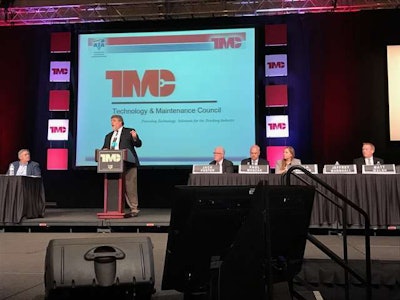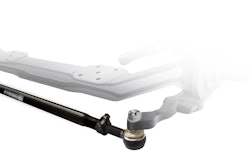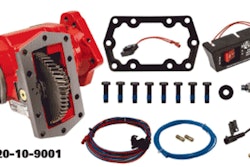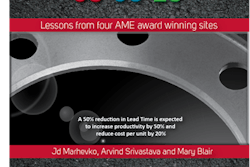 Jeff Marshall with Pricedex speaks during Tuesday’s panel discussion regarding VMRS coding and parts management at the Technology & Maintenance Council (TMC) Annual Meeting in Nashville, Tenn.
Jeff Marshall with Pricedex speaks during Tuesday’s panel discussion regarding VMRS coding and parts management at the Technology & Maintenance Council (TMC) Annual Meeting in Nashville, Tenn.Have you ever ordered something from a supplier and received significantly more, or less, than you wanted? Were you lost as to why?
During a technical session on Tuesday at the Technology & Maintenance Council (TMC) Annual Meeting in Nashville, a panel of industry experts gave you an answer.
The heavy-duty trucking industry needs standardization. It needs VMRS.
First introduced in 1970 and updated regularly since, VMRS stands for Vehicle Maintenance Reporting Standards, a coding system developed and managed by TMC.
VMRS was designed as an all-encompassing solution. It allows any business in the trucking industry to track not just parts but also assets, service, and a service event.
For suppliers and fleets using it, VMRS drives efficiency, consistency and clarity in all aspects of operation. But, unfortunately, it’s not being used by everyone.
And Tuesday’s panel says it’s time for that to change.
Speaking specifically on VMRS’s advantages in regards to parts ordering and management, Matt Walsh with Paccar Parts says VMRS and product standardization makes it easier for end users and the distribution channel to find and acquire parts. Walsh says a large portion of the aftermarket remains reliant on print catalogs, and while Walsh says these catalogs are informative, they’re still restrictive in the amount of data they can provide. They’re also uniquely designed, with no uniformity in how data is presented and how much is presented from book to book. Walsh says this is a drag on efficiency and slows the entire parts supply chain.
Standardization using VMRS would eliminate inefficiency, says Sheila Andrews with the Auto Care Association and Heavy Duty Distributor Association. Andrews says Auto Care recently completed an industry study that uncovered a willingness within the heavy-duty aftermarket to accept product reporting standardization, and is now working with other aftermarket groups to determine the needs and requirements of any future standard.
Jeff Marshall, who’s company Pricedex assisted in Auto Care’s initial survey, says the heavy-duty industry’s long-term should be a “predictable format for transmitting data” for any part, to any business within the industry.
Looking at the struggle distributors, dealers and fleet terminals face in the market today, Marshall notes: “Any time you’re receiving 300 product lines in 300 different formats you’re creating a work project” that reduces the productivity of a parts operation.
MOTOR Information Systems’ Paul Moszak chairs TMC’s S.5 Fleet Maintenance VMRS Codes Committee task force. In looking ahead to a potential standard, he says it’s all about finding a common language. Six unique part numbers for a fuel pump doesn’t change the fact that each pump does the exact same thing.
“Regardless of the manufacturer and part number that apply, an injection assembly pump is still an assembly pump,” he says.










